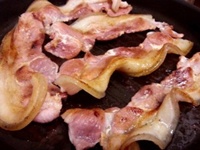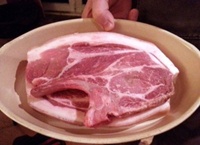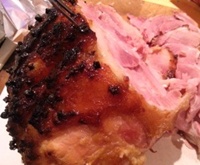![]()
The last month of being a pig ‘farmer’ was an emotional roller coaster ride as far as our eating habits were concerned. Having reared our first two free range pigs for the table this year we questioned every piece of meat we bought or cooked and whether we should be eating it at all.

Free Range Pork Back RashersOur ten-year old summed the experience up for us “oh Mum I do wish I could be vegetarian as I so love animals and don’t want to eat them, but they taste soooo good!”
It’s just as well she was thinking that way as we now have a freezer full of pork, over 120 kilo of it to be precise, from rashers to belly, hams to chops, that are set to last us for the next year!
My last blog post finished as we dropped our two saddlebacks to the abattoir on the Thursday morning. On the Saturday I took myself off to O’Gorman Meats in Castledermot, Co Kildare to discuss cuts and ask if there was any possibility that Mr G could either help with the butchering or watch it being done. It was a complete surprise to walk through the doors and instantly recognise the butcher behind the counter. Unbeknown to us, our daughter’s friend’s father managers the shop. What a relief! Several people had asked us how we could be sure we’d be getting our own pigs back. When I said hello to Brendan I instantly knew we would be.

O’Gormans Farm Shop in Athy
O’Gorman’s is a bright, clean and efficiently run establishment and it came as no surprise to see trophies in a cabinet proclaiming that they’d just won Best Rural Butcher Shop and Best Overall Butcher Shop 2013/12014 by the Associated Craft Butchers of Ireland. The let downs of butchers a few weeks ago turned into delight as I could see for myself the pride the staff felt for their workplace and the efficiency with which they carried out their trade.
Although insurance, health and safety etc prevented Mr G from having a go at butchering our pigs himself, Brendan was happy to allow him to watch and talk about the different processes and cuts. He phoned the following Wednesday letting me know that one of our pigs would be butchered that afternoon and Mr G headed off to watch.
Mr G was impressed how quickly the work was carried out. He mentioned how sharp the knives were (put all of ours to shame!) and how he was happy to leave the butchering to the experts. A short while later he arrived home with two very heavy bags of meat that had been divided, weighed and individually packed into family sized bags for us.
Eight days later I took another call from O’Gorman’s, letting me know the cured pig was ready too.
We chose to have one pig for pork and one for bacon, giving us a mixture of cuts. There’s a few pieces in there I’ve never cooked such as the collar and streaky joints so I’ll be scouring the internet for some ideas – where’s a good Pork cook book when you need one?!

4 chops = 2.5kg
Bar the kidneys, we left all the offal with O’Gorman’s though did bring one pig’s head home as well as the feet and trotters for my adventurous friend Elaine to make Brawn with. I tasted a slither and am sure if it had been enclosed in pastry and I’d been told it was a pork pie I’d have demolished it but the slither sadly stuck in my throat as I thought of the images she’d emailed me of the cooking process.
So was it worth rearing our own pigs? In answer to some of the questions asked:
- Yes! Although it was a bit of a drain on resources during the six months or so of rearing them due to the fact that we weren’t allowed to feed them out of date food or vegetable waste from shops and had to buy grain. I did however, grow a couple of beds of beans for the pigs to help with their protein intake and we fed them weeds and grubs from the garden too. Overall it was definitely cost-effective to rear our own pigs.
- The taste from free range pigs that have led a longer than usual life than factory farmed pigs is far superior to anything you’ll have tasted before. Really, there’s no comparison.
- There’s no shrinkage or milky, liquid floating around in the frying pan with the bacon.
- The meat is fattier than the factory farmed pork we had been used to but that gives it a lot more flavour and the best pork crackling eaten in our house for years.
- Pigs were by far the easiest animals we’ve ever had the pleasure of rearing and were no trouble at all, though we were summer farmers and it would have been quite a different experience heading out to feed them during this current storm!
Would we do it again? Quite likely yes once the ground has recovered. We’re also discussing the possibility of rearing chickens for the freezer on the lawn that was once used for soccer and has now become just a weekly mowing chore.
There’s something quite humbling about rearing your own meat and not taking the animal for granted that you’re about to eat. As carnivores we feel it’s important to remember that.
As we tucked in to our first home reared ham this Christmas it was with the knowledge that the animal that provided it for us had led a good life and not a factory farmed, mass-produced one.
If you’d like to try the recipe here it is, though it could be used at any time of the year and not just for Christmas… We asked our butcher to cut the joint to the size of our largest saucepan.

Honey & mustard a glazed ham recipe
- 3.5kg ham joint
- Celery, carrots, onions, bay leaf
- Water
- 1 tbsp dark brown sugar
- 2 tbsp mustard powder
- Whole Cloves
- zest from one orange
- 2 tbsp honey
Soak the ham overnight in a saucepan filled with water to remove excess salt (though this wasn’t really necessary for our free range pork), drain the pan then fill again with fresh water until the joint is covered. Add the vegetables, pop on a lid and bring the water to the boil. Simmer the ham joint for 30 minutes per kilo with the lid left on but ajar, topping up with hot water as necessary.
Once cooked, remove the ham from the water and place on one side to cool. Turn oven on to 200ºC and line a baking tin with tin foil.
Place the ham into the baking tin. Remove the outer skin from the joint but leave a good layer of fat which can be scored with a sharp knife in diamond shapes. Place a whole clove in the centre of each diamond shape.
Mix the mustard powder, honey, orange zest and brown sugar together then brush it all over the ham joint (heat the mix slightly if it isn’t runny enough to brush on). Pop the ham into the oven uncovered and cook for 20 mins, keeping an eye on it to make sure the glaze doesn’t burn.

Dee Sewell – a horticulturalist and certified trainer who started Greenside Up in 2009 and teaches people how to grow vegetables. Dee specialises in working with community gardens but also offers workshops, allotment visits, consultations, horticultural therapy, afterschools clubs as well as local talks – she tailors her services to meet clients needs. In 2012 Dee launched a Seed Gift Collection containing varieties of vegetable and insect friendly flowers with the aim of getting more people growing. Dee’s blog was a finalist in the 2012 Ireland Blog Awards in the Eco/Green and Lifestyle Categories.
Source: GreenSide Up – From Pig to Pork ~ Part 2 – Dee Sewell





